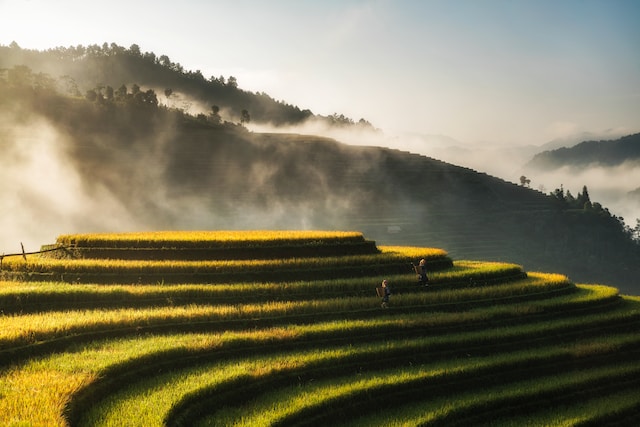In the vast landscape of agriculture, Terrace Farming stands out as a beacon of innovation, strategically designed to optimize land usage and minimize environmental footprints. This blog delves into the historical origins, contemporary applications, and the diverse advantages encapsulated within terrace farming. As a comprehensive guide tailored for both enthusiasts and seasoned farmers, we unravel the layers of this ingenious agricultural practice, showcasing how it intertwines ancient wisdom with modern solutions. Explore the fascinating journey of terrace farming, where every step taken on the terraced fields aligns with ecological consciousness and yields bountiful harvests. Join us on a transformative exploration that illuminates the significance of terrace farming in reshaping the future of sustainable agriculture.
Unearthing Ancient Wisdom of Terrace Farming
Embarking on a journey through time, the history of terrace farming unfolds as a testament to human ingenuity and the symbiotic relationship between culture and agriculture. Originating in ancient civilizations like the Inca and Asian cultures, It was a strategic response to the challenges of cultivating hilly terrain.
Inca farmers, known for their advanced agricultural practices, crafted intricate terraces in the Andes, showcasing the art of harmonizing nature with human needs. Meanwhile, Asian cultures, particularly in China and Southeast Asia, utilized terrace farming to cultivate rice paddies on steep slopes, transforming challenging landscapes into flourishing fields.
Terrace farming’s historical narrative spans continents, each region adapting the concept to its unique topography and agricultural needs. These historical echoes resonate in today’s sustainable farming practices, where terrace farming continues to thrive as a resilient and environmentally conscious approach. This journey through history unveils the roots of terrace farming, demonstrating its enduring legacy in shaping agricultural landscapes worldwide.
Maximizing Land Use in Terrace Farming
Terrace farming stands as a pinnacle in maximizing land use, employing carefully crafted steps and layers that transcend mere agricultural innovation. This method is a testament to sustainable farming practices, preventing soil erosion, conserving water, and creating microenvironments conducive to the flourishing of diverse crops. The intricate design of terraces not only transforms challenging terrains into arable land but also enhances the overall efficiency of agricultural endeavors. In embracing terrace farming, we witness a harmonious blend of ecological consciousness and agricultural productivity, unlocking the full potential of the land for the benefit of present and future generations.
Terrace Farming as a Eco-Friendly Agriculture
Terrace farming, a beacon of eco-friendly agriculture, seamlessly integrates sustainable practices into its core. This method employs natural irrigation systems, harnessing rainwater efficiently and minimizing the need for artificial inputs. The meticulously designed terraces also foster biodiversity, creating niches for various plants and organisms. As global environmental concerns intensify, terrace farming emerges as a viable solution, aligning seamlessly with the ethos of responsible agriculture. By mitigating soil erosion and optimizing water usage, terrace farming stands as a testament to the harmonious coexistence of agriculture and nature. In an era where ecological consciousness is paramount, terrace farming not only addresses contemporary environmental challenges but also paves the way for a more sustainable and resilient agricultural future.
Cultivating a Sustainable Future
Implementing terrace farming techniques involves a thoughtful blend of ancient wisdom and modern innovations. Begin by assessing the topography of the land and designing terraces that follow the natural contours. Incorporate efficient water management systems, such as contour trenching and check dams, to optimize irrigation. Employ suitable crops for each terrace, considering factors like sunlight exposure and water requirements.
Integrate organic farming practices to enhance soil fertility and reduce the need for synthetic inputs. Embrace innovative technologies like precision farming and sensor-based irrigation to monitor and manage terrace conditions effectively. Regular maintenance, including terrace stabilization and erosion control measures, is crucial for sustained success.
Community involvement and knowledge-sharing play pivotal roles. Establishing farmer cooperatives or organizing workshops can facilitate the exchange of terrace farming insights. By combining traditional wisdom with contemporary advancements, implementing terrace farming becomes a holistic endeavor that promotes sustainability, productivity, and resilience in agriculture.
Challenges and Innovative Solutions in Terrace Farming
Terrace farming, while offering numerous benefits, comes with its share of challenges. Addressing these challenges requires innovative solutions to ensure the continued success of this agricultural method.
Water Management: Efficient water distribution on terraced fields can be challenging. Implementing precision irrigation systems, rainwater harvesting, and adopting drip irrigation technologies can optimize water use and reduce wastage.
Soil Erosion: The risk of soil erosion is inherent in sloped terrains. Planting cover crops, using mulch, and installing erosion control measures, such as retaining walls and vegetative cover, can mitigate erosion and preserve soil fertility.
Crop Selection: Different terraces may have varying microenvironments. Selecting crops based on sunlight exposure, water availability, and soil conditions is crucial. Utilizing agroforestry practices and diverse cropping patterns enhances resilience.
Technology Integration: Terrace farming can benefit from modern technologies. Employing drones for land surveying, employing soil sensors for real-time data, and incorporating smart farming practices contribute to efficiency and sustainability.
Community Engagement: Establishing community-led initiatives for terrace farming promotes shared knowledge and resources. Farmers’ cooperatives, training programs, and collaborative projects create a supportive ecosystem for tackling challenges collectively.
In overcoming these challenges, terrace farming not only sustains traditional agricultural practices but also becomes a model for resilient, eco-friendly, and productive farming in the face of evolving agricultural landscapes.
Future Horizons: Terrace Farming Technologies
As agriculture evolves to meet the demands of a growing global population and address environmental concerns, the future of terrace farming holds exciting possibilities driven by innovative technologies.
Precision Agriculture: Terrace farming is poised to benefit from precision agriculture technologies. Advanced sensors, drones, and satellite imagery can provide real-time data on soil health, moisture levels, and crop conditions. Farmers can make informed decisions to optimize yields and resource use.
Vertical Farming Integration: The integration of vertical farming concepts with terrace agriculture opens up new dimensions. Utilizing vertical space on terraced slopes for stacked cultivation, incorporating hydroponics or aeroponics, and employing controlled environment agriculture methods contribute to increased productivity.
Robotics and Automation: Terrace farming can embrace robotics and automation for tasks like planting, weeding, and harvesting. Smart robots equipped with AI and machine learning algorithms can navigate terraced landscapes, performing labor-intensive activities efficiently.
Climate-Resilient Varieties: Developing crop varieties specifically tailored for terrace farming conditions is a focus of future agricultural research. These varieties will be bred to withstand slope-specific challenges, ensuring optimal growth and yield in diverse microenvironments.
Data-Driven Decision-Making: The future of terrace farming lies in data-driven decision-making. Farmers will leverage big data analytics and predictive modeling to anticipate challenges, optimize resource allocation, and implement sustainable practices for long-term success.
Sustainable Practices: Environmental sustainability will remain a key focus. Future terrace farming technologies will emphasize closed-loop systems, circular economies, and regenerative agriculture, aligning with global efforts to address climate change and promote ecological balance.
As technology continues to advance, the marriage of innovation and traditional terrace farming practices will shape a sustainable and resilient future for agriculture on sloped landscapes.

Crops on the Rise in Terrace Farming
Terrace farming’s adaptability allows for the cultivation of a diverse range of crops. The strategic layout of terraces provides microclimates suitable for various plants. Here are some crops that thrive in terrace farming:
Rice: A staple in many terrace farming regions, rice paddies are often created on flat terrace levels. The controlled water supply and leveled surfaces are ideal for cultivating rice.
Tea and Coffee: Hilly terrains are conducive to growing tea and coffee. The elevation, combined with adequate water drainage, contributes to the rich flavors of these crops.
Fruits: Orchards on terraced slopes flourish, with fruits like apples, citrus, peaches, and cherries finding optimal conditions for growth. The terraced design aids in preventing soil erosion around the delicate root systems.
Grapes: Terraced vineyards are a classic example of efficient land use. The slopes provide natural drainage, crucial for grapevines, and the angle of the terraces maximizes sunlight exposure.
Vegetables: Various vegetables find a home in terrace gardens. From potatoes to carrots and leafy greens, the tiered structure allows for organized and efficient cultivation.
Herbs and Spices: Terrace farming is well-suited for herbs and spices such as oregano, thyme, rosemary, and turmeric. The controlled environment enhances the potency of these aromatic plants.
Medicinal Plants: Many medicinal plants thrive in terrace farming conditions. Herbs like lavender, chamomile, and echinacea benefit from the well-drained, nutrient-rich terraced soil.
Cereals and Pulses: Beyond rice, terraces can support the cultivation of other cereals like wheat and barley. Pulses such as lentils and chickpeas also find a place in terrace agriculture.
The versatility of terrace farming extends to a wide array of crops, making it a sustainable and efficient method for cultivating diverse agricultural produce.
Cultural Threads: Terrace Farming Heritage
Terrace farming is not merely an agricultural practice; it is a cultural heritage deeply woven into the fabric of communities across the globe. The rich tapestry of traditions and cultural elements associated with terrace farming adds unique dimensions to its significance:
Ancient Wisdom and Traditions: Terrace farming often carries the wisdom of generations. Passed down through oral traditions, ancient techniques of terrace construction and crop selection reflect the intimate connection between communities and their land.
Festivals and Celebrations: Many cultures celebrate terrace farming through festivals and rituals. These events often mark key stages in the agricultural calendar, fostering a sense of community and shared identity among farmers.
Terrace Art and Architecture: The construction of terraces is an art form in itself. The intricate patterns of stone walls and steps, typical of terrace landscapes, often reflect the craftsmanship and cultural aesthetics of the community.
Folklore and Stories: Terrace farming regions are rich in folklore and stories that highlight the importance of these landscapes. These narratives, passed down through generations, contribute to the cultural heritage associated with the practice.
Community Bonding: Terrace farming requires collective effort. The communal nature of building and maintaining terraces fosters strong bonds among community members. Shared labor, knowledge, and resources are integral to the cultural ethos.
Culinary Traditions: The crops grown on terraces often become staples in local cuisines. The culinary traditions associated with terrace farming not only showcase the diversity of crops but also reflect the cultural identity of the region.
Sustainable Practices: Many terrace farming communities practice sustainable agriculture rooted in traditional knowledge. The harmony between human activity and nature, evident in terrace farming, is a cultural value passed down through the ages.
Terrace Poetry and Music: Some cultures express their connection to terrace farming through poetry, songs, and music. These artistic expressions often capture the essence of life in terrace landscapes, celebrating the beauty and challenges of the agricultural lifestyle.
As we marvel at the agricultural ingenuity of terrace farming, it’s essential to recognize and appreciate the cultural heritage that accompanies this ancient practice. The threads of culture intertwined with terrace farming tell stories of resilience, community, and a deep respect for the land.
Terrace Farming - A Landscape of Possibilities
Nestled between tradition and innovation, terrace farming unfolds as a landscape of endless possibilities. This ancient agricultural technique, characterized by step-like platforms carved into hillsides, not only preserves centuries-old practices but also opens the door to modern opportunities:
Historical Roots: Terrace farming’s history spans civilizations, from the rice terraces of Asia to the Andean terraces in South America. Understanding its historical roots unveils a legacy that has sustained communities for generations.
Sustainable Agriculture: At its core, terrace farming epitomizes sustainable agriculture. The tiered structure minimizes soil erosion, conserves water, and creates microenvironments conducive to diverse crops. This sustainable approach aligns seamlessly with contemporary environmental concerns.
Maximizing Land Use: A key advantage of terrace farming lies in its ability to maximize land use. The carefully crafted steps and layers prevent soil erosion, creating not just agricultural plots but a harmonious integration of the land into the community.
Eco-Friendly Practices: Terrace farming embodies eco-friendly practices, showcasing a synergy between agriculture and nature. Natural irrigation systems, biodiversity preservation, and organic cultivation methods are inherent aspects of this age-old technique.
Cultural Heritage: Beyond agriculture, terraces are cultural landscapes. They carry the weight of traditions, folklore, and communal practices. Festivals and celebrations tied to terrace farming add a layer of cultural richness to the agricultural panorama.
Tourism and Education: Terrace farming sites have become focal points for tourism and education. Visitors are drawn not only to the breathtaking landscapes but also to the cultural narratives and sustainable agricultural practices embedded in these terraced fields.
Technological Integration: Modern technology has found a place in terrace farming. From precision agriculture techniques to innovative irrigation systems, technology blends with tradition, enhancing productivity and sustainability.
Global Adaptation: The adaptability of terrace farming resonates globally. Communities worldwide are exploring its implementation to address food security challenges, particularly in regions with hilly terrain.
Crops and Biodiversity: Terrace farming encourages a diverse range of crops, fostering biodiversity. This aspect not only enhances food security but also contributes to the preservation of indigenous plant varieties.
Community Resilience: Terrace farming promotes community resilience by fostering collaboration and shared responsibility. The collective effort required to build and maintain terraces strengthens the social fabric of communities.



